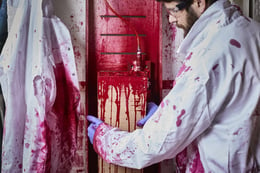Login
Registered users

“Blushing Bar” is made out of American red oak, by architects Chan+Ears and Sebastian Cox in collaboration with the American Hardwood Export Council. It is composed of 10 modules intended for making cocktails (water, alcohol, fruit, herbs, holders, ice, cutting, glass, sodas, wash basin), connect to form a circular bar, each of which forms a variation of a curved sculpted element. Zoe Chan adds: “The bar is a place of connection, a focal point for coming together. It feels very personal, much like the projects we tend to take on”. To dye the wood, Sebastian Cox and his team machined a series of uniform holes into the end grain of red oak, around 25 mm deep and 14x30 mm wide. The wood was then put into a purpose-made dying jig. The holes in the end grain were filled with red calligraphy ink. “By filling a series of holes, we can ensure the ink is distributed evenly across the board of red oak. By using calligraphy ink, we get a very intense color”, says Cox. A series of clamps are fastened onto the end of the piece of red oak applying an air-tight rubber seal over the end grain and the holes filled with ink. Once closed, a high-pressured air channel, which is attached to the clamps, is gently opened allowing eight bars of pressured air into the end grain of the wood and the ink-filled holes. This pressured air forces the ink into the uniquely ring porous structure of red oak, emptying the holes in a matter of seconds. At this point, the ink in the holes is forced through the pores of the wood, also known as xylem, by the pressured air. (Xylem is the name given to the vascular tissue in plants which sends water and dissolved nutrients upwards from the roots of and forms the woody element of the stem or trunk.) The ink in the xylem of the wood, when viewed in the machined pieces of red oak, effectively highlights what we recognise as the wood’s grain in a bright red color. These highlights are manipulated through the design and manufacture of the bar to produce the finished effect. “The properties of wood are traditionally thought of in relation to its strength, hardness and weight but when you start looking at the cellular structure of wood you can begin to explore other properties. Red oak is uniquely ring porous so this project has been a really fun exploration of its cellular composition and how we can use it to achieve a new aesthetic”, says Cox. “As a design studio we tend to work with the natural colors of the wood but it has been wonderfully freeing to use a vivid color, particularly since we have been using it to highlight the structure of the What is more, we believe really strongly that you should use what nature yields and red oak is one of the most abundant species in the American forests and suffers an unfair lack of popularity in Europe. We have really enjoyed creating something which will get people to think about less appreciated but incredibly useful materials, like red oak, in a new way”. “Considering that one of the spurious reasons often given for not using red oak is its color (a reference to the fact that it is generally warmer in tone than the white oaks from U.S. and Europe), using red ink could be seen as a provocative approach. But that is what our creative programmes do best: they challenge conventional thinking, stir debate, and most importantly, inspire. Achieving such a dramatic and exciting aesthetic effect by using red oak’s unique cellular structure is very clever and demonstrates how a better understanding of the material can inform the design process”.
ABOUT AMERICAN RED OAK
American red oak is the dominant species in the U.S. hardwood forests, making up nearly one fifth of their standing hardwood volume – with distinctive grain, and wood that is not always red in color. The name comes from the leaf color in the fall. Red oak trees grow only naturally and almost exclusively in North America, although planted elsewhere. They are widely distributed throughout most of the eastern United States in mixed hardwood forests. American red oak is growing 55.2 million m3 per year while the harvest is 33.9 million m3 per year. The net volume (after harvest) is increasing 21.3 million m3 each year – a size equivalent to five Wembley stadiums.



















